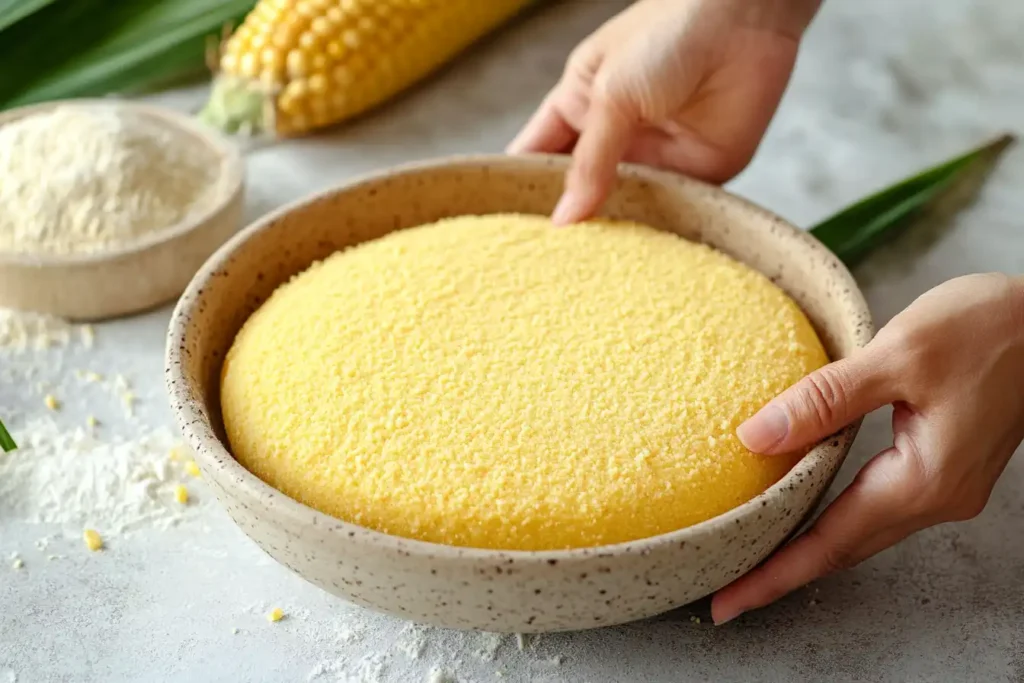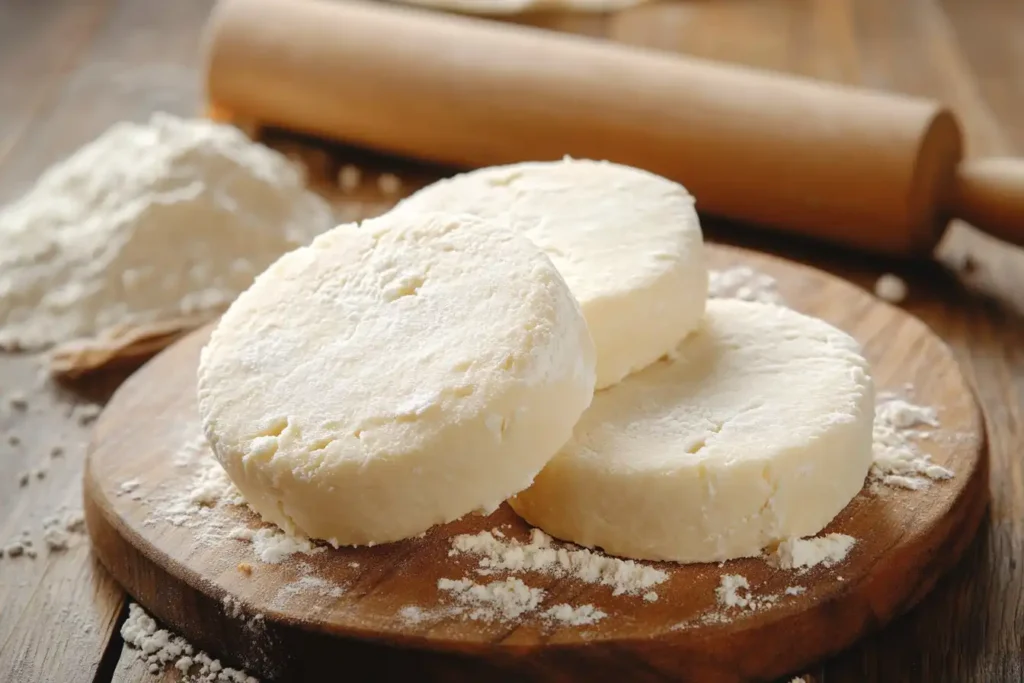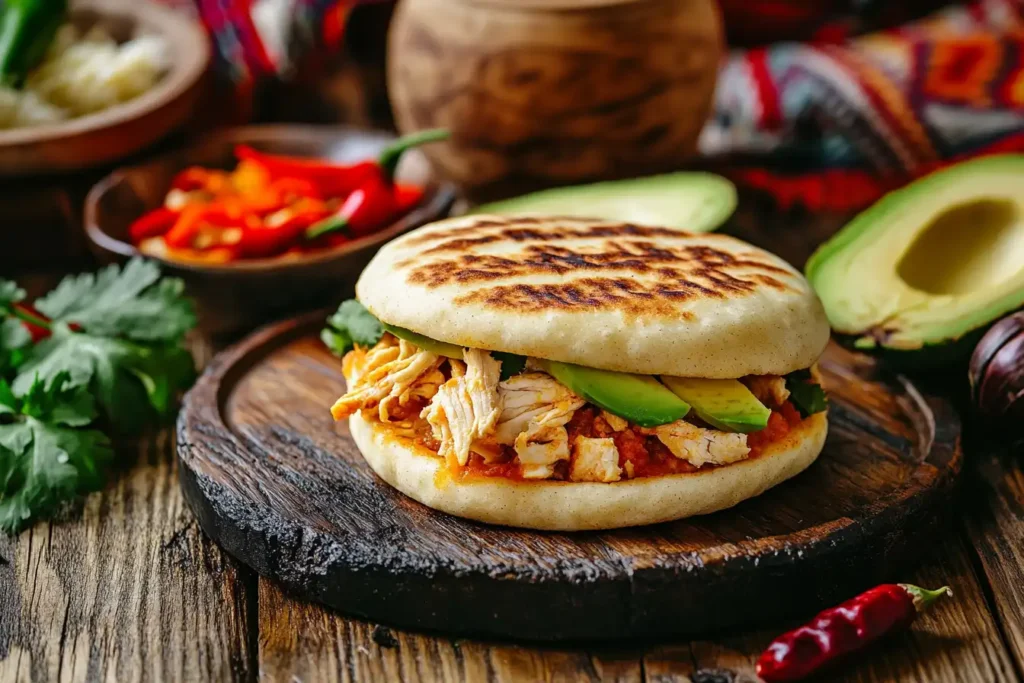The Venezuelan arepa is more than just a dish; it’s a cultural icon that connects people to their roots while satisfying their taste buds. Made from humble ingredients like cornmeal, this versatile flatbread has been cherished for centuries. Whether stuffed, grilled, or fried, arepas embody the flavors and traditions of Venezuela. In this article, we’ll explore its history, preparation, types, and much more. So, let’s uncover what makes this beloved bread a symbol of Venezuelan pride!
Introduction to Venezuelan Arepas
What Is the Name of the Venezuelan Arepa?
The name of the Venezuelan arepa—simply called “arepa”—has deep linguistic and cultural roots. Specifically, the term originates from the indigenous word erepa, which means corn. Moreover, this staple food is central to Venezuelan identity, consistently appearing on tables daily across the nation.
Historical Background of the Venezuelan Arepa
The arepa traces its history back to pre-Columbian times when indigenous tribes first ground maize into a dough. For these communities, maize was more than a crop—it was a sacred gift. When asking what is the name of the Venezuelan arepa, it’s important to recognize its deep-rooted heritage that connects directly to the indigenous term erepa. With Spanish colonization, the tradition of making arepas spread, evolving into the modern versions we know today. Its resilience through centuries of change is a testament to its cultural significance and its lasting identity as the Venezuelan arepa.
Cultural Significance of the Venezuelan Arepa in Cuisine
In Venezuela, the arepa is more than sustenance; it’s a unifying tradition. It bridges generations, reminding people of family meals and cherished moments. Whether enjoyed plain, filled with flavorful ingredients, or served as a side, the arepa is a versatile dish that reflects the diverse culinary landscape of the country.
Characteristics and Preparation of the Venezuelan Arepa
Ingredients Used in the Venezuelan Arepa Recipe
At its core, the Venezuelan arepa requires only three basic ingredients: pre-cooked corn flour (commonly sold as Harina P.A.N.), water, and salt. When exploring what is the name of the Venezuelan arepa, these ingredients highlight its simplicity and authenticity. However, these simple elements come together to create a dough that’s easy to shape and cook, forming the foundation of this iconic dish. Some variations call for a touch of butter to make the dough richer or grated cheese for added flavor. The introduction of Harina P.A.N. in the 20th century revolutionized arepa preparation by streamlining the process while preserving its traditional taste and cultural importance.
Traditional Methods of Cooking the Venezuelan Arepa
The versatility of arepas is reflected in their cooking methods. Traditionally, they are grilled on a flat pan called a budare, giving them a crisp exterior and a soft, fluffy interior. But grilling isn’t the only option—baking them in an oven ensures an even golden crust, while frying produces a crunchy shell. In some regions, boiled arepas offer a softer, moist texture, and steaming is another less common yet delightful approach. Each method lends a unique taste and texture, allowing families to experiment while maintaining tradition.
Variations in Arepa Preparation Across Venezuela
Venezuela’s regions bring their own flair to arepa preparation, making this dish as diverse as its people. When considering what is the name of the Venezuelan arepa, it’s essential to understand the regional nuances that define its identity. Coastal areas, for instance, might incorporate coconut milk for a hint of sweetness, thereby adding a unique twist to the traditional recipe. Similarly, in the Andean region, wheat flour is sometimes blended with cornmeal to create a heartier texture, showcasing a clever adaptation to local tastes. Meanwhile, in urban centers, fillings tend to be more elaborate, seamlessly combining modern influences with traditional recipes to reflect contemporary culinary trends. Meanwhile, rural areas often stick to simple yet flavorful ingredients, emphasizing fresh, locally sourced produce. This regional diversity reflects the rich culinary tapestry of the Venezuelan arepa, uniting time-honored traditions with innovative approaches.
Popular Types of Venezuelan Arepas
Arepa Reina Pepiada
One of the most iconic varieties, the Reina Pepiada, offers a creamy, savory filling of shredded chicken, ripe avocado, and mayonnaise. When exploring what is the name of the Venezuelan arepa, this beloved version stands out as a shining example of culinary artistry. This arepa, for instance, was named after Susana Duijm, the first Venezuelan to win the Miss World title in 1955, thereby celebrating her achievement with a dish as rich and elegant as her legacy. Furthermore, it is often regarded as a tribute to the sophistication of Venezuelan culture. Its luscious filling and vibrant presentation, in particular, make it a perennial favorite among arepa enthusiasts worldwide.
Arepa Pelúa
The Arepa Pelúa (literally “hairy arepa”) earns its name from the long, shredded beef it contains, which is paired perfectly with grated yellow cheese. As a result, this creates a savory combination that’s as filling as it is flavorful. Moreover, it is often enjoyed as a hearty lunch or dinner. Notably, this arepa showcases the robust and satisfying flavors that Venezuelan cuisine is widely celebrated for.
Arepa de Pabellón
Inspired by the national dish, Pabellón Criollo, this arepa brings together shredded beef, black beans, fried plantains, and white cheese. Consequently, it serves as a perfect example of how arepas can adapt to other beloved dishes, seamlessly encapsulating the essence of Venezuelan flavors in one bite. Furthermore, each ingredient contributes to a harmonious balance of sweet, salty, and savory tastes, creating a truly memorable culinary experience.
Arepa de Queso
Simplicity is key to the Arepa de Queso, which features gooey, melted cheese as its primary filling. Whether made with fresh queso blanco or aged cheese for a sharper flavor, this arepa is a staple at breakfast tables across Venezuela. It’s quick to prepare, making it a go-to snack for families on the move.
Arepa de Pernil
Often reserved for special occasions, the Arepa de Pernil is a treat that requires time and patience. The pork leg, or pernil, is marinated with a blend of spices and slow-cooked until tender. Once shredded, it is paired with tangy sauce and stuffed into the arepa, creating a festive dish that’s worth the wait.
How to Make Venezuelan Arepas at Home
Arepas are not only delicious but also surprisingly easy to make. When asking what is the name of the Venezuelan arepa, it’s essential to appreciate its simplicity and versatility. Here’s a detailed recipe to guide you through preparing these iconic Venezuelan flatbreads, ensuring you capture their authentic taste and texture.
Ingredients for the Venezuelan Arepa Recipe
- 2 cups pre-cooked white cornmeal (Harina P.A.N. recommended)
- 2 ½ cups warm water
- 1 tsp salt
- 1 tbsp butter or oil (optional, for added flavor)
Optional Add-ins:
- ½ cup grated cheese (for cheesy arepas)
- 1 tsp sugar (for a slightly sweet variation)
For cooking:
- Oil or butter for greasing the pan
Step-by-Step Instructions to Prepare the Venezuelan Arepas
1. Prepare the Dough for Venezuelan Arepas

- In a large bowl, combine warm water and salt. Stir until the salt dissolves.
- Gradually add the pre-cooked cornmeal while stirring continuously with your hand or a wooden spoon to prevent lumps.
- Knead the mixture for about 3–5 minutes until it forms a smooth, pliable dough that doesn’t stick to your hands. If it’s too dry, add a tablespoon of water at a time. If it’s too wet, sprinkle in a bit more cornmeal.
2. Shape Your Venezuelan Arepas

- Divide the dough into equal portions (about the size of a golf ball for smaller arepas or a tennis ball for larger ones).
- Roll each portion into a ball, then flatten it gently into a round disk about ½ inch thick.
3. Cook the Venezuelan Arepa
- Heat a lightly greased nonstick pan or griddle (budare if you have one) over medium heat.
- Place the arepas on the hot surface and cook for 4–5 minutes on each side, or until they develop a golden crust. Flip them gently to ensure even cooking.
- Once both sides are golden, transfer the arepas to a preheated oven (350°F / 175°C) and bake for an additional 10 minutes to ensure the center is fully cooked.
4. Serve and Fill Your Venezuelan Arepas
- Remove the arepas from the oven and let them cool slightly.
- Slice them open halfway like a pocket, and then fill them with your choice of ingredients—such as shredded chicken, avocado, cheese, beans, or any combination you love. This flexibility allows you to customize your arepa to suit your taste, making it as simple or elaborate as you desire.
- Serve warm and enjoy!
Nutritional Information for Venezuelan Arepas
Here’s the approximate nutritional content for arepas (per 100g):
| Nutrient | Amount (per 100g) |
|---|---|
| Calories | 218 kcal |
| Carbohydrates | 45 g |
| Protein | 4 g |
| Fat | 1 g |
| Fiber | 2 g |
| Sodium | 200 mg |
Note: Nutritional values may vary depending on the specific ingredients and fillings you choose.
Arepas in Venezuelan Daily Life
Role of Arepas in Venezuelan Meals
The arepa is a staple of Venezuelan cuisine, beloved for its versatility. When considering what is the name of the Venezuelan arepa, its adaptability to every meal underscores why it holds such a treasured place in the nation’s culinary heritage. From breakfast to dinner, the arepa effortlessly adapts to every meal. For instance, in the morning, it might be stuffed with eggs or cheese, pairing perfectly with a warm cup of coffee. Similarly, for lunch or dinner, heartier fillings like shredded beef or black beans transform it into a complete, satisfying dish. Even as a late-night snack, the arepa doesn’t disappoint, offering endless possibilities with its highly customizable nature. Ultimately, its enduring popularity lies in its unique ability to cater to personal tastes and dietary needs, further solidifying its reputation as a timeless favorite.
Areperas: Venezuelan Arepa Restaurants
Areperas—restaurants specializing in arepas—are truly the heartbeat of Venezuela’s culinary landscape. These vibrant eateries offer an extensive range of fillings, spanning from traditional recipes passed down through generations to innovative, modern creations. Beyond the food itself, areperas serve as welcoming gathering spots where families, friends, and travelers come together to share moments and meals. Moreover, the lively atmosphere, combined with the tantalizing aroma of freshly cooked arepas, makes them utterly irresistible destinations. Whether you’re seeking a quick bite on the go or a leisurely meal, areperas consistently deliver an authentic taste of Venezuelan culture that leaves an unforgettable impression.
Arepas in Venezuelan Celebrations and Festivals
No Venezuelan celebration is complete without arepas. Whether it’s a birthday party, a religious festival, or a national holiday, these versatile flatbreads take center stage. Families often gather to prepare large batches of arepas, transforming the cooking process into a joyous communal event. Typically filled with festive ingredients like roasted pork or spiced chicken, these arepas symbolize abundance and togetherness, embodying the spirit of celebration. Moreover, their presence at these events highlights not only their cultural significance but also their unique ability to bring people closer, fostering a sense of unity and shared tradition.
International Influence and Adaptations
Arepas in Colombian Cuisine
Though Venezuela and Colombia share the arepa as a culinary treasure, their approaches are distinct. Colombian arepas are often thinner and served plain, sometimes with just butter or cheese. Meanwhile, Venezuelan arepas are typically thicker and stuffed with elaborate fillings. The preparation styles reflect each country’s unique culinary traditions and regional preferences, offering an exciting exploration of flavors for food enthusiasts.
Global Popularity of Arepas
Thanks to the Venezuelan diaspora, arepas have gained widespread recognition worldwide. As immigrants introduce this cherished dish to their new communities, restaurants and food trucks specializing in arepas have gradually sprung up in cities across the globe. Consequently, this growing presence has brought a taste of Venezuelan culture to diverse audiences. Furthermore, the rising popularity of arepas showcases not only their universal appeal but also their unique ability to connect people through flavor and tradition. Countries like the United States, Spain, and Canada have embraced the arepa, adapting it to local tastes while preserving its authenticity. This global presence is a testament to the universal appeal of the humble arepa.
Fusion and Modern Twists on Traditional Arepas
Modern chefs have taken the traditional arepa and reimagined it with bold, innovative ideas. From gourmet fillings like smoked salmon and cream cheese to vegan variations with jackfruit and plant-based cheese, the arepa has become a canvas for creativity. These adaptations cater to contemporary palates while honoring the dish’s roots, ensuring that the arepa remains relevant and beloved across generations.
Frequently Asked Questions (FAQs)
What Is an Arepa in Venezuela?
An arepa in Venezuela is a round, flatbread crafted from cornmeal, representing a cornerstone of the country’s culinary identity. Versatile and satisfying, it’s cooked to form a crisp exterior and a soft interior. Often served stuffed or topped with an array of ingredients such as cheese, meats, or vegetables, the arepa is a reflection of Venezuela’s rich gastronomic heritage. Beyond its culinary appeal, the arepa embodies a sense of home and tradition, making it an essential part of daily life.
What Are the Most Popular Arepas in Venezuela?
Among the countless varieties of arepas, a few stand out as national favorites. The Reina Pepiada, with its creamy chicken and avocado filling, is often considered a classic. The Arepa Pelúa, featuring shredded beef and yellow cheese, offers a savory indulgence. The Arepa de Pabellón takes inspiration from the country’s national dish, combining beef, beans, plantains, and cheese for a flavorful experience. Simplicity meets satisfaction in the Arepa de Queso, which highlights the comforting taste of melted cheese. Each of these reflects the creativity and passion in Venezuelan cooking.
What Is Another Name for Arepas?
While “arepa” is the most widely recognized name, this beloved flatbread is known by other terms in specific regions. For example, indigenous communities have historically referred to it as tijitafun or fectegua. These names highlight the cultural and linguistic diversity surrounding the arepa, yet the dish remains universally celebrated under its modern moniker. No matter what it’s called, the arepa carries a universal message of comfort and connection.
What Does Reina Pepiada Mean?
The term “Reina Pepiada” directly translates to “curvy queen,” a playful and affectionate name given to honor beauty queen Susana Duijm, the first Venezuelan to win the Miss World title in 1955. This iconic arepa, filled with shredded chicken, avocado, and mayonnaise, is as rich in flavor as its story is in history. The name symbolizes grace and indulgence, celebrating both culinary and cultural pride in Venezuela.
Conclusion
The Venezuelan arepa is much more than a flatbread—it’s a symbol of heritage, versatility, and togetherness. From its indigenous origins to its modern global adaptations, the arepa reflects the heart and soul of Venezuelan culture. Popular varieties like the Reina Pepiada, Arepa Pelúa, Arepa de Pabellón, and Arepa de Queso offer a glimpse into the dish’s delicious diversity. Whether enjoyed in its homeland or discovered abroad, the arepa continues to captivate taste buds and preserve its place as a beloved culinary treasure.

